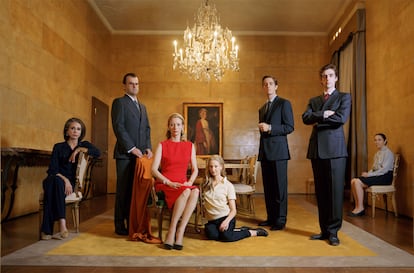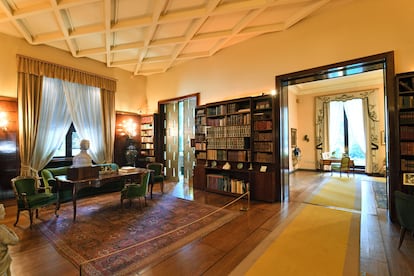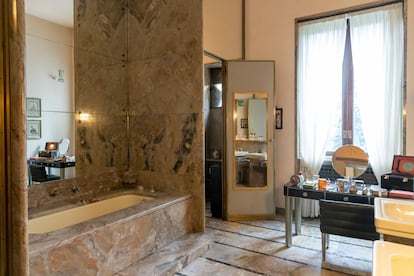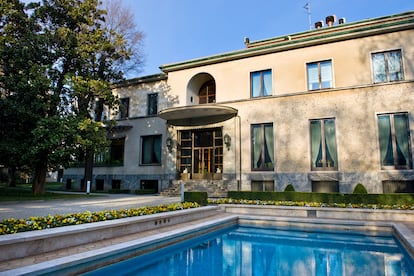Villa Necchi, the mansion that survived Mussolini and conquered Hollywood
The former family home of a series of rich industrialists from Milan was designed by Piero Portaluppi, a prolific Italian architect. Today, the residence is visited as a monument and used as a film set

British actress Tilda Swinton said that, while she and director Luca Guadagnino were immersed in the pre-production stage of the Italian romantic drama film I Am Love (2009), they were looking for a house that was “part-palace, part-museum and part-prison.” They wanted a palace, because that was the ideal habitat for the haute bourgeoisie that starred in the film. They wanted a museum, because the members of the family were presented as objects, arranged in displays outside of time and space. And the structure also had to be a prison, because the passions that were trapped there were going to overflow, as occurs during a riot, threatening to alter the strict social order that repressed them.
The film tells the story of individual liberation and the disintegration of a social class through love and sexuality. Hence, it’s understandable that Guadagnino breathed a sigh of relief when he came across the Necchi Campiglio Villa in the pages of a coffee table book: the sprawling estate had everything he was looking for. Perhaps even more.

The opening credits to the film — whose original Italian title is Io sono l’amore — are superimposed on postcards of Milan in the winter, doubly buried under a layer of snow and the solemn music of American opera composer John Adams. The wide avenues, imposing buildings and solitary parks are paraded, until we reach the walls that surround a mansion, like the walls of a fortress. This is where the fictional Recchi family lives: a filthy rich lineage of textile merchants, who likely multiplied their fortune during the fascist regime (although Guadagnino isn’t very explicit about this). The family has managed to cling to their wealth over the years, avoiding the various turbulent events of modern Italian history, like an alpine skier sliding between slalom flags.

The real owners of the house, rather than being in the textile business, were actually metal magnates. Nedda and Gigina Necchi, sisters born in 1900 and 1901 respectively, were the daughters of Ambrogio Necchi, who owned a foundry in the city of Pavia, about 25 miles from Milan. The sisters had a brother — Vittorio — who was two years older than Nedda. Ambrogio died in 1916, leaving the business to his three young offspring.
Gigina married Angelo Campiglio — nicknamed “Nene” — who abandoned his medical vocation to join the family business. A schism subsequently occurred in the family and in the emporium: Vittorio dedicated himself to the production of sewing machines, with lucrative results — it was said that there was a Necchi machine in every home in Italy — while Gigina, Nedda and Angelo created Necchi e Campiglio S.A.S, better known as NECA, which focused on the production of cast and enameled iron. They were three young and dynamic millionaires, with refined tastes, who soon decided to move from little Pavia to the more frenetic and cosmopolitan Milan, a city that was more in line with their personalities.
A story is often repeated about how, one afternoon, at the end of a performance at La Scala theatre, a dense fog flooded Milan. The chauffeur, who was driving Angelo, Gigina and Nedda, got lost in the somewhat peripheral neighborhood of Porta Venezia. Today, it’s a bohemian and artistic district, but back then, it was filled with private gardens and orchards, as well as some old, palatial estates. When a “for sale” sign appeared in front of them, a light went on in the minds of the trio.
Firstly, they acquired the land from Count Cicogna, owner of large plots in the area, and then decided to assign the building of the family house to Piero Portaluppi, a fashionable architect in interwar Milan, who was contributing to a structural facelift that was going to convert the aristocratic capital of the region of Lombardy into the most modern city in Italy. He was, therefore, the perfect person to design the home of some big capitalists, who had very new ways of operating, as well as very old interests.

Portaluppi’s flexible style encompassed a wide artistic range that didn’t rule out either classicist influences or radical rationalism. Such versatility had allowed him to tackle important projects, such as the restoration of the Brera Art Gallery and the Church of Santa Maria delle Grazie, the design of the Italian pavilion for the 1929 Barcelona International Exposition, or — just a few feet from the plot acquired by the Necchi Campiglio Villa — the Hoepli Planetarium, a sort of renovated Roman temple, whose monumentality didn’t clash with Mussolini’s taste for imperial nostalgia. In fact, shortly after this project, Portaluppi would receive (and accept) the commission for the headquarters of the Federation of Milanese Fascists in Piazza San Sepolcro. A decade later, after World War II, this work — in addition to his affiliation with the National Fascist Party and statements he made praising the fascist style as “one of the best stages of our art” — landed Portaluppi in front of the National Liberation Committee. Ultimately, however, he was acquitted of having collaborated with the deposed Mussolini regime. Apparently, his affiliation with fascism had more practical reasons than political ones. His case was a common one.
The design of the Necchi Campiglio Villa was presented in 1930 and its construction lasted between 1932 and 1935, the same year that Mussolini established Fascist Saturday, a weekly day dedicated to cultural, sports, and military activities. Although not as daring as the Corbellini-Wassermann house (Portaluppi’s next residential project), the rationalist art deco of the Necchi Campiglio Villa lived up to the modernity that his clients desired.
The exterior offers the sobriety of a Roman domus, with its orthogonal lines dotted with somewhat eccentric details, such as a small star-shaped window: a motif especially dear to its creator. The grounds are separated from the outside world by an automatic gate — a revolutionary system for the time — and then, you reach its front door after passing a heated swimming pool… the first of its kind to be installed in Milan.

Once inside, the foyer stands out, with its walnut and rosewood parquet. The stairway is imposing, with a fretted bannister. On one side, there’s a dining room, the ceiling decorated with stuccos representing the zodiac signs. And, on the other side, there’s the library, the living room and — perhaps the most portentous room — the greenhouse, with its travertine and green marble floors and transparent glass walls, overlooking the garden. The main rooms on the upper floor, meanwhile, are each equipped with a dressing room and a marble-covered bathroom. These are accessed through a hallway, which is flanked by built-in wardrobes. This detail offered a profusion of storage space, which was needed to house the vast collections of clothes and accessories that belonged to sisters Gigina and Nedda.
Portaluppi’s marble obsession is well documented: he even converted the multicolored floor of his office into a display of different stones, so that clients could point down at any point in time to choose their preference.
During World War II, the house was confiscated by the Italian government and converted into the headquarters of the fascist authorities in the city, while its owners moved to the countryside. After the war — and a period during which it was converted into the residence of the consul of the Netherlands — the Necchi-Campiglio family was able to recover it. Among frequent guests were two good friends of the family: Princess Maria Gabriella of Savoy — daughter of the last king of Italy — and her cousin, Prince Heinrich von Hesse-Kassel, also known as Enrico d’Assia, a painter and set designer. The prince was the son of a German nobleman and member of the Nazi party, who fell out of favor with Hitler and was detained by the Gestapo. His mother Princess Mafalda of Savoy died in an Allied bombing when she was a prisoner in the Buchenwald concentration camp.

In the 1950s, the house underwent a renovation that actually consisted of a trip to the past. For this project, the owners counted on Tomaso Buzzi, an architect and interior designer who was much more conventional than Portaluppi. Buzzi provided decorative details close to the sensibility of the 18th and 19th centuries (and that of the traditional bourgeois class). He put up enormous Belgian tapestries in the dining room, which distorted the original rationalist design. In the debate about why the family made such a move, the desire for the house to move away from the more modern, fascist style — which Portaluppi had praised in times that were more receptive to this discourse — cannot be ruled out.
Angelo Campiglio died in 1984, while his sister-in-law Nedda Necchi died nine years later. They were followed by an almost centenarian Gigina Necchi, in 2001. The last survivor of the trio of residents, Gigina bequeathed the property to the Fondo Ambiente Italiano (FAI), a foundation dedicated to the safeguarding of national historical heritage. After a long restoration process — which, among other objectives, tried to return it to a state as similar as possible to that conceived by Portaluppi — it was opened to the public. The art collection, which had been carefully chosen by Nedda, with works by avant-garde painters such as Lucio Fontana, René Magritte and Jean Arp, was almost entirely sold, with the proceeds going to charity. In exchange, works loaned to the FAI by gallery owner Claudia Gian Ferrari are currently on display at Villa Necchi.
Ferrari, who passed away in 2010, apparently made this offer conditional on her right to sleep in the house from time to time. In exchange, she contributed a repertoire of Italian futurists such as Boccioni, Balla and Carrà, the surrealists De Pisis and De Chirico, still lifes by Morandi, works by conceptual artists such as Alighiero and Emilietta de’Micheli, as well as sketches by Picasso, Matisse and Modigliani, among others donated by the prosperous lawyer, Guido Sforni.

Among the elements that survived Buzzi’s renovation, we must mention the sculpted sliding doors of the winter garden, which would represent the gates of the figurative prison in which Tilda Swinton, Marisa Berenson, Alba Rohrwacher and the rest of the cast of I Am Love found themselves trapped. There, Emma — the wife of the heir to an industrial fortune (a character played by Swinton) — sees how the upper-bourgeois universe that she belongs to falls apart, due to the discovery of her daughter’s lesbianism… but above all, due to her act of adultery with a young chef, the friend one of her other children. An ill-timed fish soup will trigger a series of tragic events that lead to the triumph of passion between models, who wear outfits from Fendi and Jil Sander, visits to the rooftop of the Milan Cathedral (whose square, by the way, Portaluppi redesigned in 1928) and shots of fields of wildflowers in full pollination, which contrast with the severe sumptuousness of the villa.
Years later, Ridley Scott would use this setting again, to set some scenes from House of Gucci (2021). In that film, the gardens and swimming pool of the Necchi Campiglio Villa belonged to the family patriarch, Rodolfo Gucci (played by Jeremy Irons). Portaluppi’s masterpiece demonstrated — once again — that the architecture of power is unbeatable.
Sign up for our weekly newsletter to get more English-language news coverage from EL PAÍS USA Edition
Tu suscripción se está usando en otro dispositivo
¿Quieres añadir otro usuario a tu suscripción?
Si continúas leyendo en este dispositivo, no se podrá leer en el otro.
FlechaTu suscripción se está usando en otro dispositivo y solo puedes acceder a EL PAÍS desde un dispositivo a la vez.
Si quieres compartir tu cuenta, cambia tu suscripción a la modalidad Premium, así podrás añadir otro usuario. Cada uno accederá con su propia cuenta de email, lo que os permitirá personalizar vuestra experiencia en EL PAÍS.
¿Tienes una suscripción de empresa? Accede aquí para contratar más cuentas.
En el caso de no saber quién está usando tu cuenta, te recomendamos cambiar tu contraseña aquí.
Si decides continuar compartiendo tu cuenta, este mensaje se mostrará en tu dispositivo y en el de la otra persona que está usando tu cuenta de forma indefinida, afectando a tu experiencia de lectura. Puedes consultar aquí los términos y condiciones de la suscripción digital.
More information
Archived In
Últimas noticias
Most viewed
- Reinhard Genzel, Nobel laureate in physics: ‘One-minute videos will never give you the truth’
- Oona Chaplin: ‘I told James Cameron that I was living in a treehouse and starting a permaculture project with a friend’
- Pablo Escobar’s hippos: A serious environmental problem, 40 years on
- Charles Dubouloz, mountaineering star, retires at 36 with a farewell tour inspired by Walter Bonatti
- Why we lost the habit of sleeping in two segments and how that changed our sense of time











































